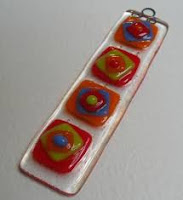If you have changed CoE (i.e., the manufacturer), then the annealing temperature is different. If you don't correct that, it's never going to work quite right.
I have several
problems with this statement.
CoE does not determine
the manufacturer. There are several manufacturers who claim to manufacture
fusing glass to the same CoE.
No manufacturer
makes to one CoE. All manufacturers have to vary the CoE of a particular glass
to balance its viscosity. The CoE is a dependent variable. It depends on what
the viscosity of the colour is. Spectrum at one point stated their System96
glass had a 10-point variation in CoE number. Oceanside will be no different. Bullseye
have stated a 5-point difference. Other manufacturers have not stated their variations.
No manufacturer can guarantee compatibility with another’s. This is because the ingredients to make a fusing range of glass varies from one manufacturer to another. These variations can make the glass incompatible. To determine if you can combine two glasses from different manufacturers you need to do the compatibility testing yourself. The CoE number does not determine the temperature characteristics of the glass either.
Annealing
Having got my disagreements with the statement out of the way, I can go on to looking at differing annealing temperatures. There is a difference between annealing point and annealing temperature.
Annealing Range
Annealing occurs over a relatively small range between the softening point at the higher end to the strain point at the lower end of the range. The softening point is the temperature, above which the glass is so plastic that it cannot be annealed. The strain point is the temperature at which the glass becomes so solid than no annealing can occur below it.
Annealing Point
The annealing point is mathematically determined as the
point at which the glass most quickly relieves the stresses within it. That temperature is determined by the viscosity of the glass. It is
known as the glass transition point, and is expressed as Tg. In practice there
are advantages in annealing at or below the published annealing point.
A soak above the annealing point is of no effect. Any
equalisation of temperature that occurs on that soak is negated by the drop to
the annealing point. It is better to spend the cumulative soak/hold time at the
(lower) annealing temperature.
Annealing Temperature
The average annealing point for Bullseye is 516°C/962°F. Different
formulations of their fusing compatible glass have different Tg temperatures. Research
showed the best results for their thick glass is 482°C/900°F. Other research in
academic institutions has shown that annealing at the lower part of the range
provides a denser and stronger finished glass piece. This applies to thick as
well as thin glass.
Bullseye has chosen to use a temperature 34°C/61°F below the
average annealing point, based on their research. This is still about 7°C/13°F
above the strain point. This approach can be applied to any fusing glass.
The strain point is approximately 43°C/78°F below the mathematically determined annealing point. If you know the annealing point you can choose to anneal – i.e., equalise the temperature of your glass – up to 30°C/54°F below that.
This has a practical demonstration. Wissmach for some
years designated 510°C/950°F as the annealing point for W96. A few years ago,
they changed their recommended annealing temperature to be 482°C/900°F. The annealing
results are good at both temperatures. The difference is that the annealing
soak is for a in longer time at the lower than at the higher temperature. But it still provides a shorter annealing cool.
Firing with different anneal points
This apparent diversion - into annealing ranges - shows that
it is possible to anneal glass with slightly different glass transition points
at the same temperature. You may compromise a little for one glass or the other.
You will also use longer times at the annealing temperature.
The annealing soak of Oceanside and Wissmach96 could both be
at 482°C/900°F. Or, if it felt safer, it can be an average of the two. The
average of the difference would make the annealing soak at 496°C/926°F. You
would use a longer soak at this temperature than at the higher one. The safest
would be to hold for an hour instead of 30 minutes for 6mm/0.25” of glass.
However, if the annealing point differs greatly, it is much
more difficult. For example, float glass with an annealing point of
540°C/1005°F would be difficult to fit in the same firing with most fusing
glass because of the wide range of official annealing points.
It is possible to anneal different glass at the same time if
the annealing points are not widely different. Compromises need to be made.

















